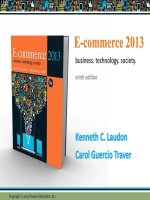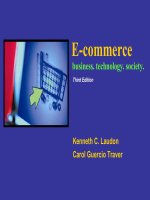Lecture E-commerce 2013: Business, technology, society (9/e): Chapter 7 - Kenneth C. Laudon, Carol Guercio Traver
Bạn đang xem bản rút gọn của tài liệu. Xem và tải ngay bản đầy đủ của tài liệu tại đây (1.92 MB, 35 trang )
E-commerce 2013
business. technology. society.
ninth edition
Kenneth C. Laudon
Carol Guercio Traver
Chapter 7
E-commerce Marketing Communications
Copyright © 2013 Pearson Education, Inc.
Class Discussion
Video Ads: Shoot, Click, Buy
What advantages do video ads have over
traditional banner ads?
Where do sites such as YouTube fit in to a
marketing strategy featuring video ads?
What are some of the challenges and risks of
placing video ads on the Web?
Do you think Internet users will ever develop
“blindness” toward video ads as well?
Copyright © 2013 Pearson Education, Inc.
Slide 7-3
Marketing Communications
Two main purposes:
Sales—promotional sales communications
Branding—branding communications
Online marketing communications
Takes many forms
Online ads, e-mail, public relations, Web sites
Copyright © 2013 Pearson Education, Inc.
Slide 7-4
Online Advertising
$37.3 billion in 2012
Advantages:
Internet is where audience is moving
Ad targeting
Greater opportunities for interactivity
Disadvantages:
Cost vs. benefit
How to adequately measure results
Supply of good venues to display ads
Copyright © 2013 Pearson Education, Inc.
Slide 7-5
Online Advertising from 2004–2016
Figure 7.1, Page 428
Copyright © 2013 Pearson Education, Inc.
SOURCES: Based on data from eMarketer, Inc., 2012a, 2012b
Slide 7-6
Forms of Online Advertisements
Display ads
Rich media
Video ads
Search engine advertising
Mobile and local advertising
Social network advertising: social networks, blogs, and
games
Sponsorships
Referrals
E-mail marketing
Online catalogs
Copyright © 2013 Pearson Education, Inc.
Slide 7-7
Display Ads
Banner ads
May include animation
Link to advertiser’s Web site
Can track user
IAB guidelines
Pop-up ads
Appear without user calling for them
Provoke negative consumer sentiment
Twice as effective as normal banner ads
Copyright © 2013 Pearson Education, Inc.
Slide 7-8
Rich Media Ads
Use Flash, HTML5, Java, JavaScript
About 5% of online advertising expenditures
Tend to be more about branding
Boost brand awareness by 10%
Far more effective than banner ads
Interstitials
Full-page ad between Web pages
Copyright © 2013 Pearson Education, Inc.
Slide 7-9
Video Ads
Fastest growing form of online advertising
IAB standards
Linear video ad
Non-linear video ad
In-banner video ad
In-text video ad
Specialized video advertising networks
Retail sites are largest users of video ads
Zappos—created video for each of 100,000 product
Copyright © 2013 Pearson Education, Inc.
Slide 7-10
Search Engine Advertising
46.5% of online ad spending in 2012
Types:
Keyword paid inclusion
Advertising keywords
Network keyword advertising or context
advertising
Nearly ideal targeted marketing
Copyright © 2013 Pearson Education, Inc.
Slide 7-11
Search Engine Advertising (cont.)
Social search
Reviews friends recommendations, searches,
Likes, and Web site visits
Search engine issues:
Paid inclusion and placement practices
Link farms
Content farms
Click fraud
Copyright © 2013 Pearson Education, Inc.
Slide 7-12
Mobile and Local Advertising
122 million users access Internet from
smartphones, tablets
Messaging
Very effective for local advertising
Display ads
Search
Video
Local advertising
Enabled by mobile platform
50% of mobile advertising
Copyright © 2013 Pearson Education, Inc.
Slide 7-13
Social Advertising
Social advertising
Uses social graph to promote message
Many-to-many model
Social network advertising
Social network sites are advertising platforms
Corporate Facebook pages
Twitter ads
Promoted tweets
Promoted trends
Promoted accounts
Copyright © 2013 Pearson Education, Inc.
Slide 7-14
Social Advertising (cont.)
Blog advertising
Top tactic
72 million read blogs
Blog readers are ideal demographic
Game advertising
In-game billboard display ads
Branded virtual goods
Sponsored banners
Branded games “advergames”
Copyright © 2013 Pearson Education, Inc.
Slide 7-15
Sponsorships and Referrals
Sponsorships
Paid effort to tie advertiser’s name to particular
information, event, and venue in a way that
reinforces brand in positive yet not overtly
commercial manner
Referrals
Affiliate relationship marketing
Permits firm to put logo or banner ad on
another firm’s Web site from which users of
that site can click through to affiliate’s site
Copyright © 2013 Pearson Education, Inc.
Slide 7-16
Insight on Society: Class Discussion
Marketing to Children of the Web in the
Age of Social Networks
Why is online marketing to children a controversial
practice?
What is the Children’s Online Privacy Protection Act
(COPPA) and how does it protect the privacy of
children?
How do companies verify the age of online users?
Should companies be allowed to target marketing
efforts to children under the age of 13?
Copyright © 2013 Pearson Education, Inc.
Slide 7-17
E-mail Marketing and the
Spam Explosion
Direct e-mail marketing
Primary cost is purchasing addresses
Spam: Unsolicited commercial e-mail
Approximately 72% of all e-mail
Efforts to control spam:
Technology (filtering software)
Government regulation (CAN-SPAM and state laws)
Voluntary self-regulation by industries (DMA )
Copyright © 2013 Pearson Education, Inc.
Slide 7-18
Percentage of E-mail That Is Spam
Figure 7.5, Page 450
Copyright © 2013 Pearson Education, Inc.
SOURCE: Based on data from Symantec, 2012.
Slide 7-19
Behavioral Targeting
Using consumer offline and online behavior to
modify advertising message
Personal information sold to third party advertisers,
who deliver ads based on profile
Ad exchanges:
Search engine queries, browsing history, social network data,
offline data
Enable advertisers to retarget ads at users as they browse
75% of U.S. advertisers employ some form of
behavioral targeting
Copyright © 2013 Pearson Education, Inc.
Slide 7-20
Mixing Offline and Online
Marketing Communications
Most successful marketing campaigns
incorporate both online and offline tactics
Offline marketing
Drives traffic to Web sites
Increases awareness and builds brand equity
Consumer behavior increasingly multichannel
80% consumers research online before buying offline
Copyright © 2013 Pearson Education, Inc.
Slide 7-21
Insight on Business: Class Discussion
Are the Very Rich Different
from You and Me?
Why have online luxury retailers had a
difficult time translating their brands and the
look and feel of luxury shops into Web sites?
Why did Neiman Marcus’ first effort fail?
Why did Tiffany’s first effort fail?
Visit the Armani Web site. What do you find
there?
Copyright © 2013 Pearson Education, Inc.
Slide 7-22
Online Marketing Metrics: Lexicon
Audience size or
market share
Conversion to
customer
Impressions
Acquisition rate
Click-through rate (CTR)
Conversion rate
View-through rate (VTR)
Browse-to-buy-ratio
Hits
View-to-cart ratio
Page views
Cart conversion rate
Stickiness (duration)
Checkout conversion
Unique visitors
rate
Abandonment rate
Retention rate
Attrition rate
Loyalty
Reach
Recency
Copyright © 2013 Pearson Education, Inc.
Slide 7-23
Online Marketing Metrics (cont.)
Social marketing
E-mail metrics
Gross rating points
Open rate
Applause ratio
Delivery rate
Conversation ratio
Click-through rate
Amplification
(e-mail)
Bounce-back rate
Unsubscribe rate
Conversion rate (e-mail)
Sentiment ratio
Duration of engagement
Copyright © 2013 Pearson Education, Inc.
Slide 7-24
An Online Consumer Purchasing Model
Figure 7.6, Page 463
Copyright © 2013 Pearson Education, Inc.
Slide 7-25









